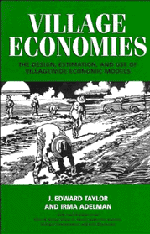Book contents
- Frontmatter
- Contents
- Acknowledgments
- 1 Introduction
- 2 Modeling village economies
- 3 The village economy and tenure security in West Africa: A Senegalese village SAM
- 4 Production and distribution in a dry-land village economy
- 5 Migration and the changing structure of a Mexican village economy
- 6 Economic linkages in a small regional economy: The case of Kutus Region, Kenya
- 7 Household nutrition and economic linkages: A village social accounting matrix for West Java, Indonesia
- 8 The village CGE: Basic model and estimation
- 9 Policy simulations
- 10 Conclusions
- Bibliography
- Index
4 - Production and distribution in a dry-land village economy
Published online by Cambridge University Press: 05 June 2012
- Frontmatter
- Contents
- Acknowledgments
- 1 Introduction
- 2 Modeling village economies
- 3 The village economy and tenure security in West Africa: A Senegalese village SAM
- 4 Production and distribution in a dry-land village economy
- 5 Migration and the changing structure of a Mexican village economy
- 6 Economic linkages in a small regional economy: The case of Kutus Region, Kenya
- 7 Household nutrition and economic linkages: A village social accounting matrix for West Java, Indonesia
- 8 The village CGE: Basic model and estimation
- 9 Policy simulations
- 10 Conclusions
- Bibliography
- Index
Summary
India's agricultural performance in the post–Green Revolution years has been adjudged moderately successful by many quarters, but rapid and sustained growth has been confined only to a few crops, notably rice and wheat, and to regions of assured rainfall or good irrigation. Nor has the Green Revolution had much of an impact on the extent of rural poverty. Thirty-nine percent of the population was below the poverty line in the 1950s, and, according to the latest estimates, 39 percent of the population was still below the poverty line in 1977–1978. Much of this poverty is concentrated in regions with little irrigation and poor rainfall, areas of unstable agriculture that have benefited little from the Green Revolution.
This study is a departure from traditional macrolevel analyses of poverty and income distribution. Instead of examining these issues at a national or regional level, the focus here is on the village economy: the structure of village production, labor supply and use, income generation and distribution, and commodity, labor, and financial flows between the village and the outside world. The social accounting matrix (SAM) provides a unifying framework for such an analysis. This chapter presents a SAM for Kanzara, a village in Akola district, a region of predominantly rain-fed and highly commercialized agriculture in western India. The SAM is used to delineate the structure of the village economy, its links with the outside world, and production and expenditure linkages within the village.
- Type
- Chapter
- Information
- Village EconomiesThe Design, Estimation, and Use of Villagewide Economic Models, pp. 59 - 100Publisher: Cambridge University PressPrint publication year: 1996
- 1
- Cited by



